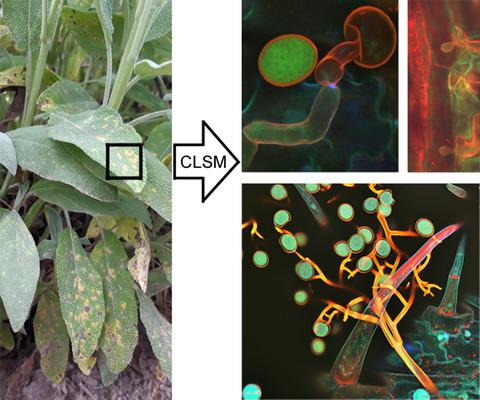当前位置:
X-MOL 学术
›
Plant Pathol.
›
论文详情
Our official English website, www.x-mol.net, welcomes your
feedback! (Note: you will need to create a separate account there.)
Tracking host infection and reproduction of Peronospora salviae‐officinalis using an improved method for confocal laser scanning microscopy (CSLM)
Plant Pathology ( IF 2.3 ) Pub Date : 2020-03-30 , DOI: 10.1111/ppa.13173 Mascha Hoffmeister 1 , Wolfgang Maier 1 , Marco Thines 2, 3 , Yvonne Becker 1
Plant Pathology ( IF 2.3 ) Pub Date : 2020-03-30 , DOI: 10.1111/ppa.13173 Mascha Hoffmeister 1 , Wolfgang Maier 1 , Marco Thines 2, 3 , Yvonne Becker 1
Affiliation

|
Peronospora salviae‐officinalis, the causal agent of downy mildew on common sage, is an obligate biotrophic pathogen. It grows in the intercellular spaces of the leaf tissue of sage and forms intracellular haustoria to interface with host cells. Although P. salviae‐officinalis was described as a species of its own 10 years ago, the infection process remains obscure. To address this, a histological study of various infection events, from the adhesion of conidia on the leaf surface to de novo sporulation is presented here. As histological studies of oomycetes are challenging due to the lack of chitin in their cell wall, we also present an improved method for staining downy mildews for confocal laser scanning microscopy as well as evaluating the potential of autofluorescence of fixed nonstained samples. For staining, a 1:1 mixture of aniline blue and trypan blue was found most suitable and was used for staining of oomycete and plant structures, allowing discrimination between them as well as the visualization of plant immune responses. The method was also used to examine samples of Peronospora lamii on Lamium purpureum and Peronospora belbahrii on Ocimum basilicum, demonstrating the potential of the presented histological method for studying the infection processes of downy mildews in general.
中文翻译:

使用改进的共聚焦激光扫描显微镜 (CSLM) 方法跟踪丹参霜霉病的宿主感染和繁殖
Peronospora salviae-officinalis 是鼠尾草霜霉病的病原体,是一种专性生物营养病原体。它生长在鼠尾草叶组织的细胞间隙中,形成细胞内吸器与宿主细胞接触。尽管 P. salviae-officinalis 在 10 年前被描述为一种独特的物种,但其感染过程仍不清楚。为了解决这个问题,这里介绍了各种感染事件的组织学研究,从分生孢子在叶表面的粘附到从头孢子形成。由于卵菌的组织学研究由于其细胞壁中缺乏几丁质而具有挑战性,因此我们还提出了一种用于共聚焦激光扫描显微镜染色霜霉病的改进方法,以及评估固定未染色样品的自发荧光潜力。对于染色,a 1:发现苯胺蓝和台盼蓝的 1 混合物最适合,用于染色卵菌和植物结构,允许区分它们以及植物免疫反应的可视化。该方法还用于检查紫花蓍草上的霜霉病菌和罗勒上的霜霉病菌的样本,证明了所提出的组织学方法在研究一般霜霉病感染过程中的潜力。
更新日期:2020-03-30
中文翻译:

使用改进的共聚焦激光扫描显微镜 (CSLM) 方法跟踪丹参霜霉病的宿主感染和繁殖
Peronospora salviae-officinalis 是鼠尾草霜霉病的病原体,是一种专性生物营养病原体。它生长在鼠尾草叶组织的细胞间隙中,形成细胞内吸器与宿主细胞接触。尽管 P. salviae-officinalis 在 10 年前被描述为一种独特的物种,但其感染过程仍不清楚。为了解决这个问题,这里介绍了各种感染事件的组织学研究,从分生孢子在叶表面的粘附到从头孢子形成。由于卵菌的组织学研究由于其细胞壁中缺乏几丁质而具有挑战性,因此我们还提出了一种用于共聚焦激光扫描显微镜染色霜霉病的改进方法,以及评估固定未染色样品的自发荧光潜力。对于染色,a 1:发现苯胺蓝和台盼蓝的 1 混合物最适合,用于染色卵菌和植物结构,允许区分它们以及植物免疫反应的可视化。该方法还用于检查紫花蓍草上的霜霉病菌和罗勒上的霜霉病菌的样本,证明了所提出的组织学方法在研究一般霜霉病感染过程中的潜力。











































 京公网安备 11010802027423号
京公网安备 11010802027423号